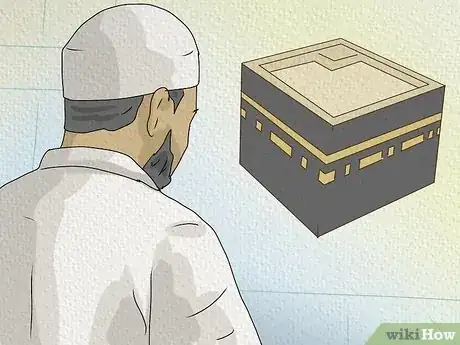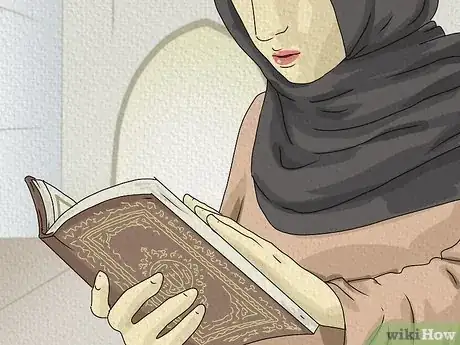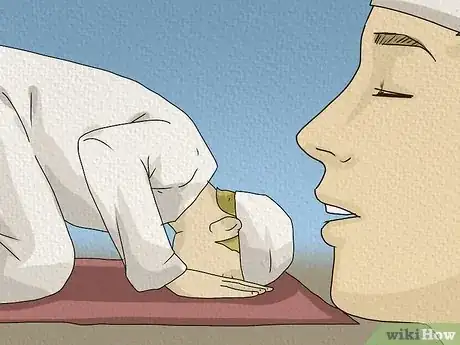This article was co-authored by wikiHow staff writer, Finn Kobler. Finn Kobler graduated from USC in 2022 with a BFA in Writing for Screen/Television. He is a two-time California State Champion and record holder in Original Prose/Poetry, a 2018 finalist for the Los Angeles Youth Poet Laureate, and he's written micro-budget films that have been screened in over 150 theaters nationwide. Growing up, Finn spent every summer helping his family's nonprofit arts program, Showdown Stage Company, empower people through accessible media. He hopes to continue that mission with his writing at wikiHow.
wikiHow marks an article as reader-approved once it receives enough positive feedback. In this case, 100% of readers who voted found the article helpful, earning it our reader-approved status.
This article has been viewed 422,376 times.
Learn more...
The Ishraq prayer (also known as Duha) is an optional prayer for Muslims to perform just as the sun rises. You can perform the Ishraq prayer to make up for wrongdoings and lesser sins, but many people choose to pray Ishraq because of the good deeds that it’s said to stand for. (Some Muslim scholars even believe performing the Ishraq after the mandatory sunrise prayer, Fajr, can help you achieve paradise.) In this article, we’ll give you an easy step-by-step guide to performing Ishraq. By the end, you’ll see it’s just as easy as any other prayer. Plus, it can greatly benefit your spiritual well-being!
Things You Should Know
- Perform Ishraq 15-20 minutes after the sun rises and once you’ve completed your mandatory Fajr Salaah. Stay seated in the time between these two prayers.
- Face the Qibla when praying Ishraq. If you’re praying from a country west of Mecca, pray to the east. If you’re praying from a country to Mecca's east, face west.
- Recite 2 rak’ahs (units of prayer) when performing Ishraq. Start by reciting Surah Fatiha (the opening verse). Then, state another surah (chapter) before bowing.
- Conduct at least 2 rak’ahs when performing Ishraq. However, you can recite more if you feel like it. Most Muslims pray an even number of rak’ahs during Ishraq.
Steps
Preparing for Ishraq
-
1Set an alarm to wake up for the Fajr and Ishraq prayers. The Ishraq prayer is performed about 15-20 minutes after the sun rises. It requires you to remain seated after performing the mandatory sunrise prayer (Fajr Salaah) and remember Allah until it is appropriate to begin reciting your rak’ahs (units of prayer) again. To ensure you rise in time to perform Fajr and Ishraq, research what time the morning sun will rise in your city before you go to bed. Set an alarm for that time.[1]
- If you lose track of time, look at the position of the sun over the horizon. If the sun has completely risen and no parts of it appear to be touching the skyline, you can begin your prayer.
-
2Get rid of anything in the room that might distract you. While you’re praying, maintain complete focus and avoid thinking about anything other than the task at hand. To help you keep your concentration, remove your phone from your room, turn off your television, and take a moment of complete silence to center yourself.[2]
- It’s okay to have a fan running or noise in the background if it’s unavoidable. Just work on blocking out the extra sounds while you’re praying.
Advertisement -
3Perform wudu to prepare your body for salah. In Islam, you have to purify yourself before praying. Since you’ve just woken up to say Ishraq, clean yourself using the cleansing ritual of wudu. To perform wudu, rinse your hair once from the forehead to the back of your head and wash your hands, mouth, face, arms, and feet three times each.[3]
- Wudu must be performed in the specific ritual order, starting with the hands, then moving to the mouth and face, then lower arms, then the hair, and then the feet.
-
4Turn your body to face Qibla. Face the Holy Mosque in Mecca while you are praying. This is a very special place of worship for Muslims around the world, and is the location of the Kaaba, an important relic. To face the direction of the Qibla, find where you are in relation to the Kaaba. If you live east of Al Haram, Mecca, Saudi Arabia (where the Holy Mosque is located), face west in your prayer. If you live west, face east.[4]
- To help you with directions, try downloading a “Qibla compass” app on your phone. This is a modified compass that points in the direction of the Holy Mosque.
- In the United States, many people disagree on what direction they should face to say prayers. However, most North American Muslims face northeast when they pray.
Saying the Ishraq Prayers
-
1State your intentions for saying Ishraq. Understand your reasons for praying before you recite any prayers. Do you want to cleanse yourself of lesser sins? To say extra thanks to Allah? Perhaps you just want to start your day on a positive note. Whatever your reasoning, think about how many rak'ahs you will perform and why you’re doing them. Then, quietly say your intentions for performing Ishraq out loud.[5]
- You might say “I pray two rak'ah Ishraq for Allah while facing toward Kaaba to ask for forgiveness of my wrongdoings.”
- Your intention could also be something like “Today is a holiday, and I am performing Ishraq to encourage good deeds in the world in the name of Allah.”
-
2Start your Ishraq prayer. Begin praying by reading Surah Fatiha (the opening prayer of the Quran), followed by another surah (chapter) of your choosing. Then, bow down into Ruku by bending over until your hands are placed directly over your knees. Finally, prostrate yourself into Sujood with your palms, toes, knees, and forehead all touching the floor.[6]
- Say the surahs in Arabic, since they come from the Quran. Personal prayers can be said in your native language.
- Keep your voice low when reciting your rak’ahs so that only you can hear yourself.
- It is recommended to recite Ayatul Kursi up until “Khalidoon” after Surah Fatiha. However, you may choose any memorized verse that feels appropriate.
-
3Perform another rak'ah. After you’ve completed your first prayer, return to the standing position and recite Surah Fatiha again. Choose a different surah from your first rak’ah to recite after Fatiha. Then, continue with the rest of the rak'ah, bowing into Ruku and prostrating into Sujood when appropriate.[7]
- The recommended surah for your second rak’ah is Aamanar Rasul until the end of “Suratul Baqarah.”
-
4Say as many rak’ahs as you feel are necessary. Ishraq only requires you to perform 2 rak’ahs for your prayers, but say more if you want to. Many Muslims believe that Ishraq is a very powerful prayer. Therefore, performing more rak'ahs can help you achieve your prayer’s intention more fully.[8]
- Most people say an even number of rak’ahs for Ishraq, even if they perform more than the required amount.
Community Q&A
-
QuestionIf I don't know Surah Fatiha in Arabic, is it okay to use my phone and repeat after the person who is performing in Arabic?
 wikiHow Staff EditorThis answer was written by one of our trained team of researchers who validated it for accuracy and comprehensiveness.
wikiHow Staff EditorThis answer was written by one of our trained team of researchers who validated it for accuracy and comprehensiveness.
Staff Answer wikiHow Staff EditorStaff AnswerIshraq is an optional prayer. If you cannot complete every step perfectly, that's okay. Avoid using your phone for prayer and do the best you can without aid.
wikiHow Staff EditorStaff AnswerIshraq is an optional prayer. If you cannot complete every step perfectly, that's okay. Avoid using your phone for prayer and do the best you can without aid. -
QuestionAssalamualaikum! I once heard if we pray Fajr and sit in the same place until Ishraq, we get the reward of Hajj. Is this true?
 wikiHow Staff EditorThis answer was written by one of our trained team of researchers who validated it for accuracy and comprehensiveness.
wikiHow Staff EditorThis answer was written by one of our trained team of researchers who validated it for accuracy and comprehensiveness.
Staff Answer wikiHow Staff EditorStaff AnswerSome believe this is true. Sayyiduna Anas Ibn Malik (radiyallahu ‘anhu) reported that Nabi (sallallahu ‘alayhi wa sallam) said: "Whoever offers his Fajr salah in congregation, and then remains seated remembering Allah until after sunrise, and then he offers two rakats of salah (Ishraq), will receive the reward of one complete Hajj and one complete ‘Umrah.’"
wikiHow Staff EditorStaff AnswerSome believe this is true. Sayyiduna Anas Ibn Malik (radiyallahu ‘anhu) reported that Nabi (sallallahu ‘alayhi wa sallam) said: "Whoever offers his Fajr salah in congregation, and then remains seated remembering Allah until after sunrise, and then he offers two rakats of salah (Ishraq), will receive the reward of one complete Hajj and one complete ‘Umrah.’" -
QuestionIs Chasht prayer different from Ishraq?
 wikiHow Staff EditorThis answer was written by one of our trained team of researchers who validated it for accuracy and comprehensiveness.
wikiHow Staff EditorThis answer was written by one of our trained team of researchers who validated it for accuracy and comprehensiveness.
Staff Answer wikiHow Staff EditorStaff AnswerChasht is another name for the prayer, used interchangeably with Ishraq and Duha.
wikiHow Staff EditorStaff AnswerChasht is another name for the prayer, used interchangeably with Ishraq and Duha.
Warnings
- If you’re a woman, say Ishraq at home. Women are not allowed to pray Ishraq at a mosque.⧼thumbs_response⧽
References
- ↑ http://sunnirazvi.net/practices/prayers.htm
- ↑ https://www.islamicfinder.org/news/7-common-distractions-of-khushoo-faced-in-salah/
- ↑ https://www.alislam.org/library/book/salat/prayer-offered-in-abnormal-circumstances/
- ↑ http://www.islamicacademy.org/html/Learn_Now/English/Salah_In_Audio.htm
- ↑ http://www.islamicacademy.org/html/Learn_Now/English/Salah_In_Audio.htm
- ↑ http://sunnirazvi.net/practices/prayers.htm
- ↑ http://sunnirazvi.net/practices/prayers.htm
- ↑ https://fiqh.islamonline.net/en/duha-al-ishraq-prayers-any-distinction/
About This Article
Start your Ishraq prayer standing and facing the Qibla while you consider your intentions for the prayer. Once you are ready, begin the first rak'ah. After reciting Surah Fatiha, recite another surah. Then, complete the first rak'ah and move into the second rak'ah, repeating what you did in the first rak'ah. You can repeat as many rakats as you’d like before finishing your prayer. For more tips, including deciding when to start Ishraq, scroll down!







































































